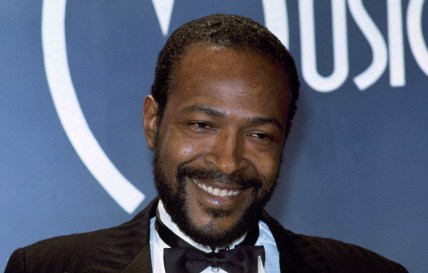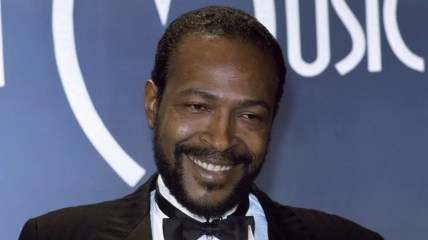‘We’re all sensitive people:’ Marvin Gaye’s ‘Let’s Get It On,’ an expression of anxiety and fear disguised as sexual phantasm
In recognition of the 50th anniversary of Marvin Gaye's landmark album, "Let's Get It On," theGrio explores the not-so-hidden messages of dread and rejection interweaved with the sensual production and performances.
Since its Aug. 28, 1973 release, Marvin Gaye’s “Let’s Get It On” album has been the Rosetta Stone of what has come to be known as “baby-making music.” For the past 50 years, listeners have relied on it to initiate and enhance carnal knowledge of an object of desire, and singers and producers use it as their North Star to replicate Gaye’s insatiable melodic atmosphere.
Duality made Gaye’s music so compelling and enduring throughout and beyond his living days. “Let’s Get It On” begins the listeners’ peek into the realm of polarity that both benefited and plagued Gaye. He discusses the album’s duality in the liner notes:
“I contend that SEX IS SEX and LOVE IS LOVE. When combined, they work well together if two people are of the same mind. But they are really two discrete needs and should be treated as such.”

The simplistic explanation of how the duality of sex and love is represented in the album is implicit. The music — the instrumental performances and production — represents sex. The lyrics and themes of the songs represent love. However, in reality, music and the lyrics aren’t working together as much as they co-exist because the lyrics express love in a far more harsh subtext.
“Let’s Get It On” is actually more sad and poignant than it would appear. Many of its songs deal with longing, loneliness, frustration, fear and heartbreak.
Except for the title track and its reprise, “Keep Getting It On,” each song on the album finds Gaye focusing more on the pursuit of satisfaction rather than the achievement of satisfaction. Even when he focuses on finer aspects of sexual euphoria, it is accompanied by a sense of foreboding loss.

Top 10 Motown albums of all time
“You Sure Love To Ball” is inarguably the most sexually explicit song on the album, with an intro that features a woman moaning mid-coitus over a slithering saxophone and swelling strings. And yet, it ends with Gaye lamenting about his lover’s impending disappearance.
“All I know, I know if we had to ever part,
That one day would surely break my heart,
I got to get ready, got to get ready.”
“Come Get to This” works on the same feeling in conversing order. It’s easily the most buoyantly joyous track on the project, thanks to Gaye’s doo-wop drenched background vocal, James Jamerson’s typically genius bass and the bouncy downbeat from the floor tom. But the song’s built on the notion that Gaye’s love has returned after being gone for a long time. Singing “I nearly went out of my mind,” he conveys this sense of insecurity and impatience.
“Please Stay (Once You Go Away)” speaks of the void that Gaye feels whenever his object of desire is out of the picture. He pleads with her not to go because he knows how much his life will wither without her: “Scared that if I close my eyes, when I get ready to wake up, I might find you gone” indicates fear.
The messaging behind “If I Should Die Tonight” is affirming and laudatory. The slow-burning ballad tells his lover that he’s experienced the rapture and comfort of love that “millions never, and millions never will.” However, the morbid presence of looming death still dominates the song’s undercurrent.
The album’s centerpiece, “Distant Lover,” embodies the full range of Gaye’s emotions to their most extreme. Instrumentally playing out like a hazy, soulful mini-suite, Gaye recalls a summer fling with a beautiful woman. He pours his heart out after their daily correspondence via letter abruptly ends, leaving him to “gaze out my window down a lonesome road” and lament in his heartbreak:
“Sugar, how can you treat my heart so mean and cruel,
Didn’t you know, sugar,
That every moment that I spent with you,
I treasured it like it was a precious jewel.“
Even with the ebb and flow of Gaye’s fear and fantasy, the thermostat still showed palpable humidity in terms of maintaining the sensual temperature for the listener through the first seven songs. For the album’s finale, Gaye caved into his futility and accepted the demise of his union with “Just to Keep You Satisfied.”
The sparse arrangement contained little more than bass, strings, and background vocals from Gaye and his Motown protégés, The Originals. The song lays out the dissolution of his marriage. Gaye’s so conversational in lead vocal that the song scarcely even rhymes, mimicking authentic stream-of-consciousness singing.
Phrases like “the really happy times we had can really never outweigh the bad” and “it’s too late for you and me” make “Just to Keep You Satisfied” among the most somber, sorrowful breakup songs in American history.
Polarity still reigns on the aforementioned title track and “Keep Getting It On.” Both deal with Gaye pleading with his potential lover to acquiesce any reluctance or inhibition of his sexual advances. Not only does Gaye immediately contradict himself by going from patience to impatience — “I ain’t gonna worry, I ain’t gonna push, I won’t push you, baby, come on, baby, stop beating ’round the bush” — but he also juxtaposes sexual with spiritual.
He ends the title track with “feeling, so good, somethin’ like sanctified” and “Keep Getting It On” with “Jesus is trying to tell the people to come on, and get it on.”
“Let’s Get It On” is not the first album to fuse the sacred with the secular. R&B and soul music is built on the foundation of borrowing sonic textures, arrangements, chord progressions and vocal delivery with themes and lyrics that celebrate fleshly desires. “Let’s Get It On” is, however, one of the first R&B albums to lean into the thematic intertwining of sex and religion with such unveiled intentionality.
The album is the beginning of Gaye manifesting the self-sabotage of domestic bliss and reaching the unreachable. He went on to obsess about the contradictions dictating his every move in life and the studio, evident in albums like “Here, My Dear,” songs like “Sanctified Lady” and his relationship with his second wife, Janis Hunter, which was full of abuse, addiction and masochism.
“Let’s Get It On” will continue to help lead couples to the bedroom for 50 more years. But its true legacy is how sensuality can mask one’s inner conflicts, restlessness and dread, which can be summed up when considering the bookending statements on this album: The first song begins with the line, “I’ve been really tryin’, baby/tryin’ to hold back this feeling for so long.” The last song ends with the line, “Oh well, all we can do is we can both try to be happy.”

Matthew Allen is an entertainment writer of music and culture for theGrio. He is an award-winning music journalist, TV producer and director based in Brooklyn, NY. He’s interviewed the likes of Quincy Jones, Jill Scott, Smokey Robinson and more for publications such as Ebony, Jet, The Root, Village Voice, Wax Poetics, Revive Music, Okayplayer, and Soulhead. His video work can be seen on PBS/All Arts, Brooklyn Free Speech TV and BRIC TV.
TheGrio is FREE on your TV via Apple TV, Amazon Fire, Roku and Android TV. Also, please download theGrio mobile apps today!


